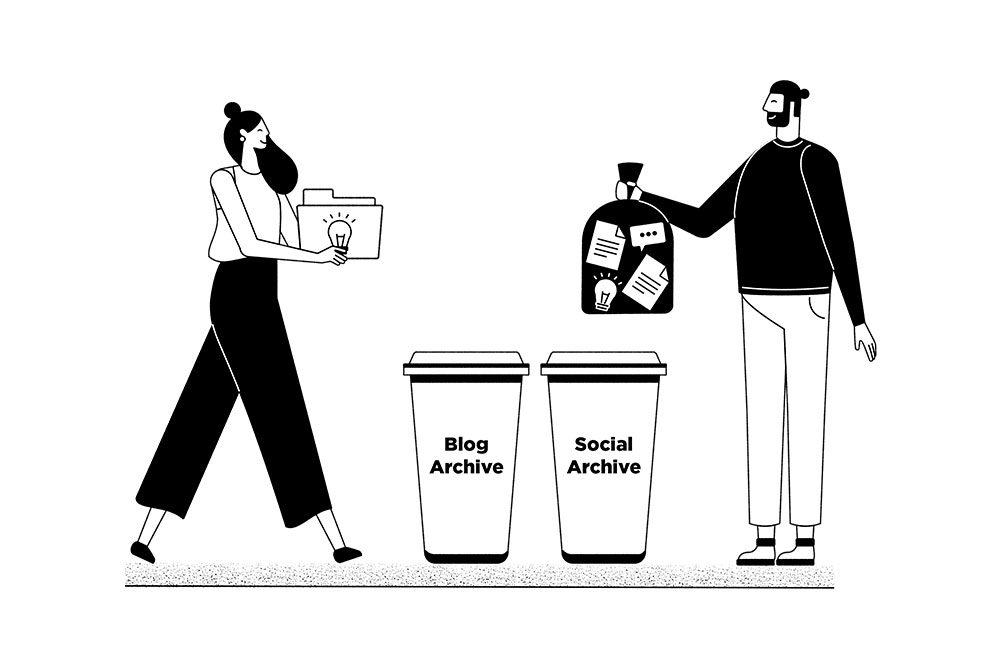Branding
The secret to content marketing? Content recycling!
Nope, you’re not cheating. Welcome to the perpetual content cycle!

Content creation is a time-consuming job that requires a lot of energy. However you look at it, keeping your target audience engaged by providing them with rich content on a frequent basis is a challenge. What’s more, your mind is not constantly brimming with revolutionary ideas and occasionally you might find yourself suffering from a spell of creator or writer’s block. The pressure is real, but what if we told you that you don’t have to constantly reinvent the wheel? In this blog post we will reveal the ultimate secret to smart content creation.
It’s (ever)green and it’s great.
Content recycling! This is the art of breathing new life into forgotten content gems that you already have lying around in your archives. You undoubtedly have content available that you or your content team have spent a ton of work on. It’s a shame when those pieces end up never seeing the light of day again after that first publish. You can give your old content a new look and send it back out into the world. But hold on, do realize that squeezing your content to the very last drop is allowed, but it has its limits. More than anything else, make sure you know how your target group prefers to process information and ensure that your content remains relevant and dignified at all times.
No doubt about it. It works.
You can assume that not everyone noticed every single piece of content you ever published – even if they did, they didn’t necessarily read and look at it carefully. So repurpose that fun content and do something new with it! Why is this such a smart move?
- It’s a boost for your SEO –Updating old content is a good way to get back on the radar of the search engines. Google loves it. When an old link starts getting more traffic again, Google will see your page as relevant again and you will rank better in search results. What’s more, it also boosts your click-through-rate. This is a percentage indicating how many clicks a link generates when it is shown to the audience. If you update an old blog, it will automatically receive a new date, which makes a much better impression. A link dating back to 2015 or 2021 – the choice is easily made.
- It extends your reach –for sure. When you repurpose content in a different form, you reach a new audience through a different channel. Of course, your target audience remains the same, but not everyone processes content in the same way. A larger reach means more leads and therefore a higher chance of conversions.
- It is the ideal test to find out which content types and channels work best for your target audience.
Let’s get it started.
Channels and content types galore. It’s up to you to get your message across to your target audience in a creative and refreshing way. But how do you get started? Make sure to remember these steps during your recycling process:
- Analyse your content archives.
Set up a spreadsheet where you group all content by channel, content type and target audience. Then analyze the data of each piece of content. How much traffic, engagement and conversions did you generate? How do you rank in search results? Be aware though, not only content that performed well is worth recycling. It is also interesting to check where things went wrong with content that was less popular. The topic may be good, but the approach or channel may not work well for your target audience. - Define your target audience’s desires.
Your target audience is at the centre of everything you do. That is why you should map out the needs and desires of your target group. In what form and through which channel do they prefer to consume your content? - Recycle and upcycle.
You create and publish content, learn from the data and then take your content to a higher level or give it a new look. The possibilities are endless – the sky is truly the limit here. Below we list some ideas for you: - Upcycle your blog post by adding a template, framework or checklist.
- Make an infographic of your blog post.
- Bundle your blog articles into an e-book.
- Make a video of your webinar.
- Repurpose your blog post into LinkedIn slides.
- Record a podcast episode about one of your blog articles.
- Make social media posts of your articles.
Create, publish, analyse & recycle.
Integrating content recycling into your strategy is a must for your content marketing. It is the last and also the smartest link that will complete the content cycle. One that will help you reach a wider audience, generate more leads and drive more conversions. That is music to your ears, isn’t it? Let’s give it a try!
Do you still feel like calling it quits? Our team has what it takes to help you better position your brand.